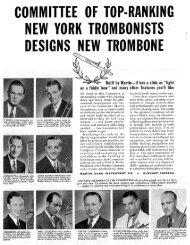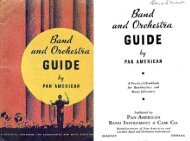Horn-u-copia - Theory of design of trumpets and cornets?
Horn-u-copia - Theory of design of trumpets and cornets?
Horn-u-copia - Theory of design of trumpets and cornets?
Create successful ePaper yourself
Turn your PDF publications into a flip-book with our unique Google optimized e-Paper software.
<strong>Horn</strong>-u-<strong>copia</strong> - <strong>Theory</strong> <strong>of</strong> <strong>design</strong> <strong>of</strong> <strong>trumpets</strong> <strong>and</strong> <strong>cornets</strong>?Back to topkevinMajor ContributorOfflineTrumpets, <strong>cornets</strong>, flugel<strong>and</strong> alto horns, for now.Posts: 217Sylvan Lake, Alberta,CanadaGender:View Pr<strong>of</strong>ile Email Email WWWRe: <strong>Theory</strong> <strong>of</strong> <strong>design</strong> <strong>of</strong> <strong>trumpets</strong> <strong>and</strong><strong>cornets</strong>?Reply #27 - Sep 5 th , 2012 at 6:43pmQuote Modify Split Removehttp://www.cosmolearning.com/video-lectures/on-trumpet-mouthpieces<strong>and</strong>-tone-part...This is worth watching, I'm sure some have seen this series <strong>of</strong> lectures butfor anyone who hasn't they are great fun <strong>and</strong> he makes it interesting. Onepoint he makes is that it's not only the mouthpiece <strong>and</strong> the instrument, butalso the mouthpiece <strong>and</strong> the player that makes the difference. Mouthpiecesare funny things. Only certain brass have them. As we know the Saxdoesn't. Mouthpieces bring some interesting things to an instrument butalso raise some difficult issues.Back to topView Pr<strong>of</strong>ile Email Email Personal Message50.93.86.61kevinMajor ContributorOfflineTrumpets, <strong>cornets</strong>,flugel<strong>and</strong> alto horns, fornow.Posts: 217Sylvan Lake, Alberta,CanadaGender:Re: <strong>Theory</strong> <strong>of</strong> <strong>design</strong> <strong>of</strong> <strong>trumpets</strong> <strong>and</strong><strong>cornets</strong>?Reply #28 - Yesterday at 10:22amQuote Modify Split RemoveNiner wrote on Sep 5 th , 2012 at 12:14pm:Certainly there are actual tone differences among a cornet <strong>and</strong> atrumpet <strong>and</strong> a flugelhorn ..... there must be a set <strong>of</strong> parameters thatmake a trumpet a trumpet <strong>and</strong> a cornet a cornet....As Kenton said, there "are" theoretically different parameters that guidethe <strong>design</strong> <strong>of</strong> this class but on close inspection <strong>of</strong> many examples <strong>of</strong> eachthese guidelines are known to be blurred <strong>and</strong> indefinite. The cornet issupposed to be more conical than the trumpet. Because there is generallymore length <strong>of</strong> tubing before the valves, the bells <strong>and</strong> stems flare morerapidly than on a trumpet.Within the same pitch, the length <strong>of</strong> tubing on all the crooks is the same orvery close. Flugels shouldn't be included in any comparison <strong>of</strong> <strong>trumpets</strong><strong>and</strong> <strong>cornets</strong> as they belong to a radically different branch <strong>of</strong> the family. Themodern flugel is more <strong>of</strong>ten than not a soprano saxhorn. The originalflugels are scarcely seen today. The French call them Bugles <strong>and</strong> theItalians the Soprano Flicorno. There is clearly as much confusion in thisfamily <strong>of</strong> instruments as there is between the trumpet <strong>and</strong> cornet. At onelevel, the business <strong>of</strong> <strong>design</strong> <strong>and</strong> the instruments themselves representmore a matter <strong>of</strong> "intent" than anything else. The slight variations in detail,the different mouthpieces <strong>and</strong> shanks, the expectations <strong>of</strong> the players <strong>and</strong>audience <strong>and</strong> the differing styles <strong>of</strong> music all go together to maintain thissupposed divide between the two. The complaint for many years in the mid20th century was that the cornet was being <strong>design</strong>ed to sound more <strong>and</strong>more like a trumpet <strong>and</strong> from the trumpet school, the <strong>trumpets</strong> werebeginning to sound more <strong>and</strong> more like <strong>cornets</strong>. In fact both instrumentswere bowing to public taste <strong>and</strong> musical fashion <strong>and</strong> were to a large extentmerging toward one another. There is a joke that says "in the battlebetween the trumpet <strong>and</strong> the cornet, the cornet won." Trumpet playershate that sort <strong>of</strong> talk, but in fact, neither won. Both instruments haveevolved along the same lines.If we look at an old Boston 5 star or a Lyon & Healy "Own Make" or justfile:///L|/Temp/<strong>Horn</strong>-u-<strong>copia</strong>%20-%20<strong>Theory</strong>%20<strong>of</strong>%20<strong>design</strong>%20<strong>of</strong>%20<strong>trumpets</strong>%20<strong>and</strong>%20<strong>cornets</strong>2%20.htm[9/7/2012 12:29:17 PM]




